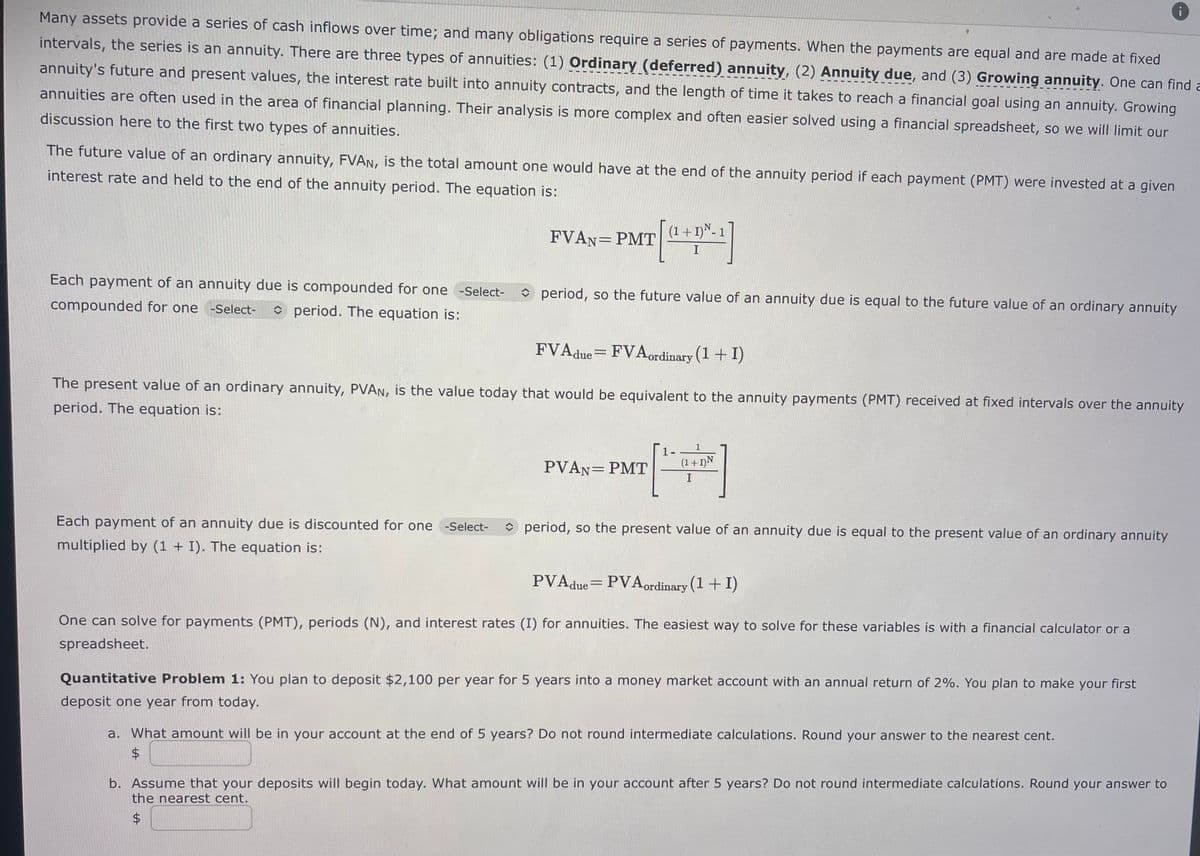Quantitative Problem 1: You plan to deposit $2,100 per year for 5 years into a money market account with an annual return of 2%. You plan to make your first deposit one year from today. a. What amount will be in your account at the end of 5 years? Do not round intermediate calculations. Round your answer to the nearest cent. $ b. Assume that your deposits will begin today. What amount will be in your account after 5 years? Do not round intermediate calculations. Round your answer to the nearest cent. $
Quantitative Problem 1: You plan to deposit $2,100 per year for 5 years into a money market account with an annual return of 2%. You plan to make your first deposit one year from today. a. What amount will be in your account at the end of 5 years? Do not round intermediate calculations. Round your answer to the nearest cent. $ b. Assume that your deposits will begin today. What amount will be in your account after 5 years? Do not round intermediate calculations. Round your answer to the nearest cent. $
Chapter11: Capital Budgeting Decisions
Section: Chapter Questions
Problem 9MC: The process that determines the present value of a single payment or stream of payments to be...
Related questions
Question

Transcribed Image Text:Many assets provide a series of cash inflows over time; and many obligations require a series of payments. When the payments are equal and are made at fixed
intervals, the series is an annuity. There are three types of annuities: (1) Ordinary (deferred) annuity, (2) Annuity due, and (3) Growing annuity. One can find a
annuity's future and present values, the interest rate built into annuity contracts, and the length of time it takes to reach a financial goal using an annuity. Growing
annuities are often used in the area of financial planning. Their analysis is more complex and often easier solved using a financial spreadsheet, so we will limit our
discussion here to the first two types of annuities.
The future value of an ordinary annuity, FVAN, is the total amount one would have at the end of the annuity period if each payment (PMT) were invested at a given
interest rate and held to the end of the annuity period. The equation is:
Each payment of an annuity due is compounded for one -Select-
compounded for one -Select- period. The equation is:
FVAN= PMT
Each payment of an annuity due is discounted for one -Select-
multiplied by (1 + I). The equation is:
(1+
period, so the future value of an annuity due is equal to the future value of an ordinary annuity
FVAdue=FVAordinary (1+1)
The present value of an ordinary annuity, PVAN, is the value today that would be equivalent to the annuity payments (PMT) received at fixed intervals over the annuity
period. The equation is:
I
PVAN= PMT
[
1
(1+1) N
I
period, so the present value of an annuity due is equal to the present value of an ordinary annuity
PVA due = PVA ordinary (1+1)
One can solve for payments (PMT), periods (N), and interest rates (I) for annuities. The easiest way to solve for these variables is with a financial calculator or a
spreadsheet.
Quantitative Problem 1: You plan to deposit $2,100 per year for 5 years into a money market account with an annual return of 2%. You plan to make your first
deposit one year from today.
a. What amount will be in your account at the end of 5 years? Do not round intermediate calculations. Round your answer to the nearest cent.
$
b. Assume that your deposits will begin today. What amount will be in your account after 5 years? Do not round intermediate calculations. Round your answer to
the nearest cent.
$

Transcribed Image Text:Quantitative Problem 2: You and your wife are making plans for retirement. You plan on living 30 years after you retire and would like to have $95,000 annually on
which to live. Your first withdrawal will be made one year after you retire and you anticipate that your retirement account will earn 10% annually.
a. What amount do you need in your retirement account the day you retire? Do not round intermediate calculations. Round your answer to the nearest cent.
$
b. Assume that your first withdrawal will be made the day you retire. Under this assumption, what amount do you now need in your retirement account the day
you retire? Do not round intermediate calculations. Round your answer to the nearest cent.
$
Expert Solution
This question has been solved!
Explore an expertly crafted, step-by-step solution for a thorough understanding of key concepts.
This is a popular solution!
Trending now
This is a popular solution!
Step by step
Solved in 2 steps

Knowledge Booster
Learn more about
Need a deep-dive on the concept behind this application? Look no further. Learn more about this topic, finance and related others by exploring similar questions and additional content below.Recommended textbooks for you

Principles of Accounting Volume 2
Accounting
ISBN:
9781947172609
Author:
OpenStax
Publisher:
OpenStax College

Cornerstones of Financial Accounting
Accounting
ISBN:
9781337690881
Author:
Jay Rich, Jeff Jones
Publisher:
Cengage Learning

EBK CONTEMPORARY FINANCIAL MANAGEMENT
Finance
ISBN:
9781337514835
Author:
MOYER
Publisher:
CENGAGE LEARNING - CONSIGNMENT

Principles of Accounting Volume 2
Accounting
ISBN:
9781947172609
Author:
OpenStax
Publisher:
OpenStax College

Cornerstones of Financial Accounting
Accounting
ISBN:
9781337690881
Author:
Jay Rich, Jeff Jones
Publisher:
Cengage Learning

EBK CONTEMPORARY FINANCIAL MANAGEMENT
Finance
ISBN:
9781337514835
Author:
MOYER
Publisher:
CENGAGE LEARNING - CONSIGNMENT